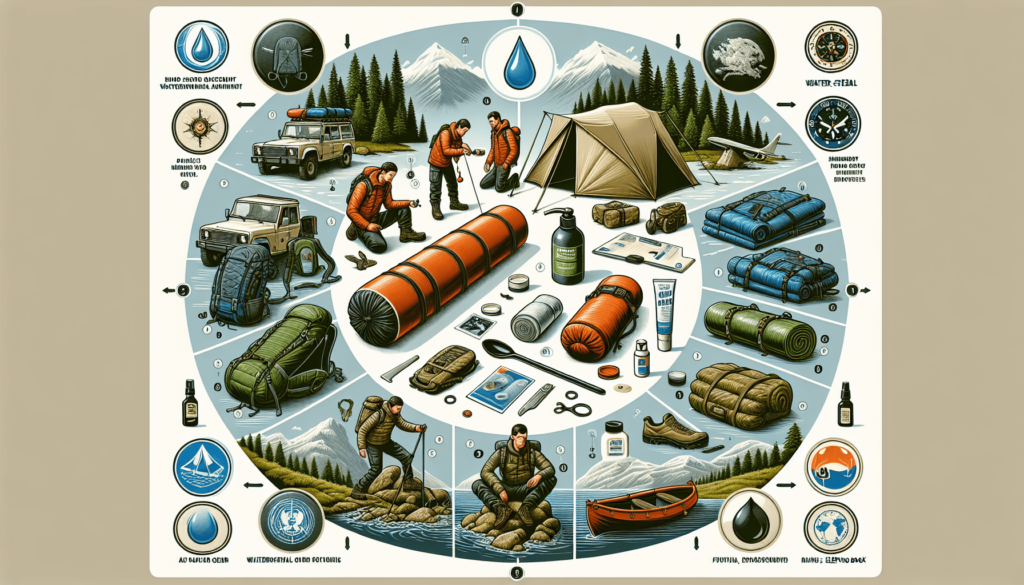Are you an adventurous spirit with a love for off-roading and outdoor camping? If so, you’ve probably experienced the struggle of keeping your precious overland gear dry during unexpected downpours or water crossings. In this article, we will explore a few simple yet effective techniques to help you waterproof your overland gear, ensuring that your equipment remains dry and protected no matter what Mother Nature throws your way. So, sit back, relax, and get ready to discover the secrets to dry and worry-free adventures!

Choosing the Right Gear
When it comes to choosing overland gear that is waterproof, it’s important to understand the waterproof ratings of the products. Waterproof ratings are measured in millimeters and indicate how much water pressure the gear can withstand before water starts to seep through. The higher the rating, the more waterproof the gear is. So, when searching for gear, look for items with higher waterproof ratings for better protection against the elements.
In addition to understanding waterproof ratings, it is also important to research the different waterproof materials used in gear. Common waterproof materials include Gore-Tex, eVent, and coated nylon. Each material has its own advantages and disadvantages, so it’s important to consider factors such as breathability, durability, and weight when making a decision. Take the time to research and compare different materials to find the best option for your specific needs.
Once you have a good understanding of waterproof ratings and materials, it’s time to select the right waterproof gear options for your overlanding adventures. Consider the specific activities you will be engaging in and the conditions you will encounter. For example, if you will be crossing rivers or hiking in wet environments, investing in waterproof boots and a waterproof backpack might be essential. Look for gear options that are specifically designed for outdoor activities and offer the necessary waterproof features to keep your gear and belongings dry.
Pre-Treatment of Gear
Before you head out on your overlanding trip, it’s important to pre-treat your gear to ensure maximum waterproofing. This involves cleaning the gear, applying a water repellent spray, and sealing the seams.
Start by cleaning your gear thoroughly to remove any dirt, debris, or oils that may interfere with the waterproofing process. Follow the manufacturer’s instructions for cleaning and make sure to use appropriate cleaning products that are compatible with the gear material.
After cleaning, apply a water repellent spray to enhance the gear’s waterproof capabilities. These sprays create a protective barrier that helps repel water and prevent it from seeping through the fabric. Be sure to choose a spray that is suitable for the specific material of your gear, as different materials require different types of waterproofing sprays.
Lastly, it’s important to seal the seams of your gear to prevent water from seeping through the stitching. Use a seam sealer or waterproof tape to seal any exposed seams. Pay close attention to areas that are prone to leakage, such as pockets, zippers, and joints. This extra step will ensure that your gear remains fully waterproofed and ready for any adventure.
Waterproofing Bags and Packs
Waterproof bags and packs are essential for keeping your gear and belongings dry during your overlanding trips. There are several options available for waterproofing your bags and packs, including using waterproof dry bags, using pack liners, and applying waterproof sprays or wax.
One of the easiest and most effective ways to waterproof your gear is by using waterproof dry bags. These bags are made from waterproof materials and feature a secure closure system, such as a roll-top or zip-lock, to keep water out. Simply place your gear inside the dry bag, roll or seal the closure, and you’re ready to go. Dry bags come in various sizes, so choose one that fits your gear and allows for easy organization.
Another option for waterproofing your bags is to use pack liners. Pack liners are lightweight, waterproof bags that are designed to line the inside of your backpack or pack. They create a second layer of protection against water, ensuring that your gear stays dry even in the most wet conditions. Pack liners are typically made from waterproof materials such as nylon or PVC, and they come in different sizes to fit different pack capacities.
If you have a bag or pack that is not inherently waterproof, you can still make it water-resistant by applying a waterproof spray or wax. These products create a protective barrier on the surface of the fabric, making it harder for water to penetrate. Follow the instructions provided with the spray or wax to ensure proper application and effectiveness. Keep in mind that waterproof sprays and waxes may need to be reapplied periodically, especially after prolonged use or exposure to harsh weather conditions.
Waterproofing Clothing and Footwear
Keeping your clothing and footwear dry is crucial for staying comfortable and safe during your overland adventures. When selecting waterproof clothing and footwear, it’s important to choose the right fabrics, apply waterproofing sprays or wax, and seal seams and zippers.
Start by choosing clothing and footwear made from waterproof fabrics. Common waterproof fabrics include Gore-Tex, eVent, and coated nylon. These fabrics are designed to repel water while allowing moisture and sweat to escape, keeping you dry and comfortable. Look for clothing and footwear that have sealed seams, as this helps prevent water from seeping through the stitching.
In addition to choosing waterproof fabric, you can further enhance the waterproof capabilities of your gear by applying waterproofing sprays or wax. These products create a protective barrier on the surface of the fabric, making it more resistant to water. Follow the instructions provided with the spray or wax, and be sure to apply it evenly and thoroughly for optimal results.
Don’t forget to pay attention to seams and zippers on your clothing and footwear. Seams and zippers are common areas where water can seep through, so it’s important to seal them properly. Use a seam sealer or waterproof tape to seal any exposed seams, and apply a zipper wax or silicone lubricant to keep zippers functioning smoothly and waterproof.

Waterproofing Electronics and Gadgets
Protecting your electronics and gadgets from water damage is essential, especially when overlanding in wet and unpredictable conditions. There are several options available for waterproofing your electronics and gadgets, including using waterproof cases, applying liquid screen protectors, and using waterproof pouches or bags.
One of the most effective ways to waterproof your electronics is by using waterproof cases. These cases are specifically designed to provide maximum protection against water, dust, and shock. They come in different sizes to fit various devices, such as smartphones, cameras, and GPS devices. Waterproof cases typically feature a secure closure system, such as a rubber seal or screw-lock, to ensure that no water can penetrate the case.
If you don’t have a waterproof case for your device, you can still provide some level of protection by applying a liquid screen protector. Liquid screen protectors create a thin, invisible layer of protection that repels water and prevents scratches on your device’s screen. Follow the instructions provided with the screen protector to ensure proper application and effectiveness.
For smaller electronics or gadgets that don’t require full waterproof protection, using waterproof pouches or bags can be a convenient solution. These pouches or bags are made from waterproof materials and feature a secure closure system, such as a zip-lock or roll-top, to keep water out. Simply place your device inside the pouch or bag, seal the closure, and you can confidently carry it with you in wet conditions.
Waterproof Storage Solutions
Having waterproof storage solutions is essential for keeping your gear organized and protected during your overlanding trips. There are several options available for waterproof storage, including investing in waterproof containers, using dry bags or sacks, and utilizing waterproof organizer pouches.
Investing in waterproof containers is a great option for protecting larger gear or items that need extra security. Waterproof containers are made from durable materials, such as hard plastic or aluminum, and feature a tight-sealing lid or closure system to keep water out. These containers come in various sizes and shapes, so you can find the perfect one to fit your specific needs.
For smaller or more flexible items, using dry bags or sacks is a practical solution. Dry bags and sacks are made from waterproof materials and feature a roll-top or zip-lock closure to create a watertight seal. These bags come in different sizes and are ideal for storing clothes, personal items, and smaller gear such as camping equipment or tools.
To keep your smaller gear organized within your larger storage containers or backpacks, utilizing waterproof organizer pouches can be a game-changer. These pouches are made from waterproof materials and feature multiple compartments or pockets for easy organization. They come in different sizes and can be used to store items such as toiletries, first aid supplies, or electronics.
Maintenance and Care
Proper maintenance and care of your waterproof gear is vital for ensuring its longevity and effectiveness. By following a few simple steps, you can keep your gear in excellent condition and ready for your next overlanding adventure.
One of the most important aspects of maintenance is drying your gear properly. After each use, make sure to hang or lay out your gear in a well-ventilated area to allow it to air dry completely. Avoid direct sunlight or high heat sources, as they can damage the fabric or coatings. It’s also important to dry off any excess water or moisture from your gear before storing it to prevent mold or mildew growth.
Regular inspections and repairs are also crucial for maintaining your waterproof gear. Check for any signs of wear and tear, such as fraying seams or worn-out coatings. If you spot any issues, make necessary repairs or consider replacing the gear if it’s beyond repair. This will help prevent future leaks and ensure that your gear remains in top condition.
When it comes to storing your gear, it’s important to keep it in dry conditions. Moisture can deteriorate gear over time, so choose a storage area that is cool, dry, and well-ventilated. Avoid storing your gear in damp basements or hot attics, as these environments can promote mold growth or damage the materials.
Tips for Waterproofing in Extreme Conditions
In extreme conditions, additional precautions may be necessary to ensure maximum waterproofing. Utilizing double layering can provide an extra barrier against water penetration. Consider wearing multiple layers of clothing or utilizing double bags for extra protection. This creates an additional layer of insulation and prevents water from reaching your gear or body.
Another important consideration is making seasonal gear adjustments. Different seasons present different challenges, so make sure to adjust your gear accordingly. For example, in colder months, it may be necessary to invest in insulated waterproof clothing or add extra layers to keep warm. In warmer seasons, focus on lightweight and breathable gear that still offers adequate waterproofing.
Reapplying waterproofing as needed is also crucial for maintaining the effectiveness of your gear. Over time, waterproof coatings may lose their effectiveness or wear off, especially with regular use. Keep an eye on your gear’s performance and be proactive in reapplying waterproofing sprays or wax as needed. This will ensure that your gear remains fully waterproof and ready for any weather conditions.
Testing Waterproofing
Before heading out on your overlanding adventures, it’s important to test the waterproofing of your gear. Performing a water test is a simple and effective way to determine if your gear is providing the necessary protection.
To perform a water test, fill a sink or bathtub with water and submerge your gear. Pay close attention to areas that are prone to leakage, such as seams, zippers, and closures. Allow the gear to sit in the water for a few minutes, and then carefully inspect it for any signs of water penetration. If you notice any leaks, take note of the problem areas and address them before using the gear in real-world conditions.
Observing your gear in various weather conditions can also help identify any potential leaks or weaknesses. Take your gear out in different weather conditions, such as rain or snow, and pay attention to how it performs. If you notice any water seeping through or dampness inside the gear, it may be an indication that it requires additional waterproofing or maintenance.
Remember to always address any leaks or issues promptly. Small leaks can quickly escalate into larger problems, compromising the integrity of your gear and potentially ruining your overlanding experience. By identifying and addressing leaks early on, you can ensure that your gear remains fully waterproof and reliable.
Knowing the Limitations
While proper waterproofing techniques can significantly enhance the water resistance of your gear, it’s important to understand that not all gear can be fully waterproofed. Some gear may have limitations due to design, materials, or construction.
Consider the functional trade-offs when deciding on the level of waterproofing you need. Some gear may sacrifice breathability for improved waterproofing, while others may prioritize lightweight design over maximum water resistance. Determine what features are most important for your specific needs and make an informed decision based on those priorities.
If you’re uncertain about the waterproofing capabilities of your gear or need advice on specific products, don’t hesitate to seek expert advice. Outdoor gear specialists or manufacturers can provide valuable insights and recommendations based on their expertise and experience. They can help guide you towards the best waterproof gear options for your overlanding adventures.
In conclusion, waterproofing your overland gear is essential for protecting your belongings and ensuring a comfortable and enjoyable outdoor experience. By understanding waterproof ratings, researching waterproof materials, and selecting the right gear options, you can set yourself up for success. Pre-treating your gear with cleaning, water repellent spray, and seam sealing will further enhance its waterproof capabilities. Whether it’s waterproofing bags and packs, clothing and footwear, electronics and gadgets, or storage solutions, there are various methods available to keep your gear dry. Regular maintenance and proper care, along with testing the waterproofing and knowing the limitations of your gear, will help you stay prepared for any adventure. So, gear up, waterproof your supplies, and embark on your overlanding journey with confidence.

